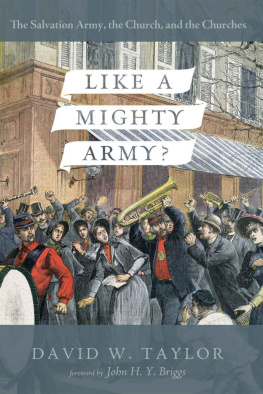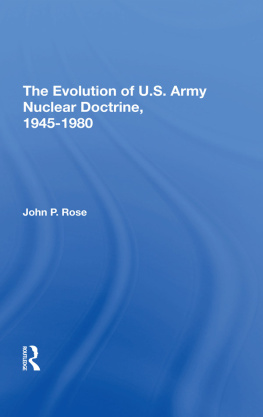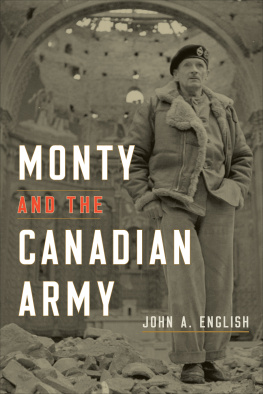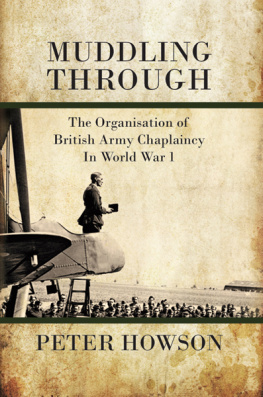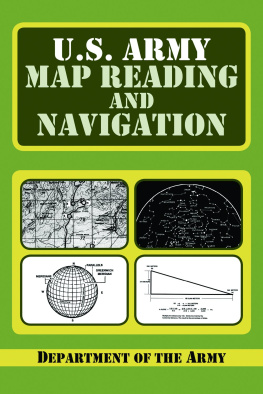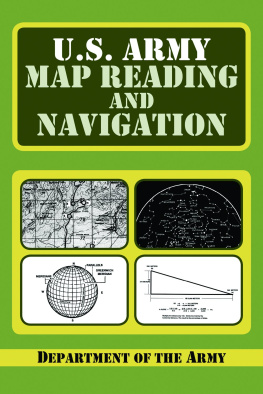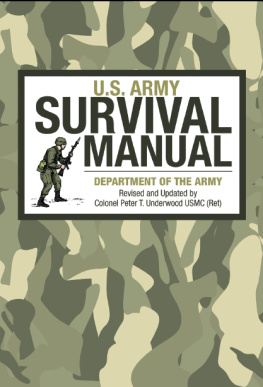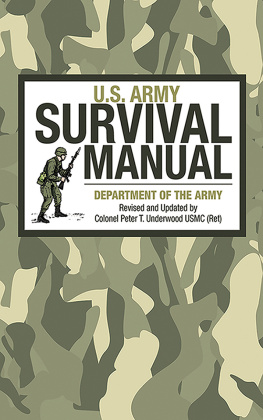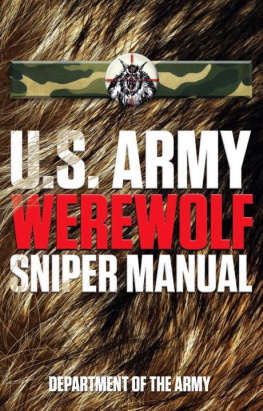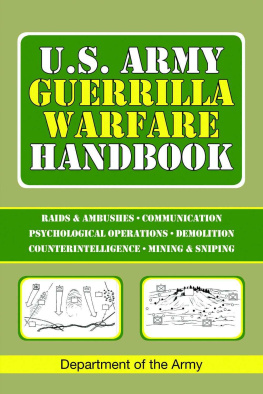Briggs John H. Y. - Like a Mighty Army?: The Salvation Army, the Church, and the Churches
Here you can read online Briggs John H. Y. - Like a Mighty Army?: The Salvation Army, the Church, and the Churches full text of the book (entire story) in english for free. Download pdf and epub, get meaning, cover and reviews about this ebook. City: La Vergne, year: 2014, publisher: Pickwick Publications, an Imprint of Wipf and Stock Publishers, genre: Religion. Description of the work, (preface) as well as reviews are available. Best literature library LitArk.com created for fans of good reading and offers a wide selection of genres:
Romance novel
Science fiction
Adventure
Detective
Science
History
Home and family
Prose
Art
Politics
Computer
Non-fiction
Religion
Business
Children
Humor
Choose a favorite category and find really read worthwhile books. Enjoy immersion in the world of imagination, feel the emotions of the characters or learn something new for yourself, make an fascinating discovery.
- Book:Like a Mighty Army?: The Salvation Army, the Church, and the Churches
- Author:
- Publisher:Pickwick Publications, an Imprint of Wipf and Stock Publishers
- Genre:
- Year:2014
- City:La Vergne
- Rating:5 / 5
- Favourites:Add to favourites
- Your mark:
- 100
- 1
- 2
- 3
- 4
- 5
Like a Mighty Army?: The Salvation Army, the Church, and the Churches: summary, description and annotation
We offer to read an annotation, description, summary or preface (depends on what the author of the book "Like a Mighty Army?: The Salvation Army, the Church, and the Churches" wrote himself). If you haven't found the necessary information about the book — write in the comments, we will try to find it.
Like a Mighty Army?: The Salvation Army, the Church, and the Churches — read online for free the complete book (whole text) full work
Below is the text of the book, divided by pages. System saving the place of the last page read, allows you to conveniently read the book "Like a Mighty Army?: The Salvation Army, the Church, and the Churches" online for free, without having to search again every time where you left off. Put a bookmark, and you can go to the page where you finished reading at any time.
Font size:
Interval:
Bookmark:

The Salvation Army, the Church, and the Churches
David Taylor
With a Foreword by John H. Y. Briggs

LIKE A MIGHTY ARMY?The Salvation Army, the Church, and the Churches
Copyright 2014 David Taylor. All rights reserved. Except for brief quotations in critical publications or reviews, no part of this book may be reproduced in any manner without prior written permission from the publisher. Write: Permissions, Wipf and Stock Publishers, W. th Ave., Suite , Eugene, OR 97401 .
Pickwick Publications
An Imprint of Wipf and Stock Publishers
W. th Ave, Suite
Eugene, OR 97401
www.wipfandstock.com
isbn : 978-1-62564-436-7
eisbn : 978-1-63087-500-8
Cataloging-in-Publication data:
Taylor, David.
Like a mighty army? : the Salvation Army, the church, and the churches / David Taylor ; foreword by John H. Y. Briggs
xviii + p. ; cm. Includes bibliographical references and index.
isbn : 978-1-62564-436-7
. Salvation ArmyDoctrines . . Church.. Barth, Karl, 18861968 . I. Briggs, John H. Y. II. Title.
BX9721 T195 2014
Manufactured in the U.S.A.
To Kathy, Anna, Jenni, Sam and Samuel, and the Church in Wood Green
D avid Taylors Like a Mighty Army? is a fine example of a study of the interplay of historical research, theological interrogation, and the analysis of emerging ecclesiastical practice, well illustrating the impact of the mental exercise of historical and theological enquiry on the practical issue presently confronting The Salvation Army in exploring the nature of its identity and mission in the modern world. Thus, the roots of the movement are traced back, religiously, to North American Holiness movements, derived as they were from John Wesleys own convictions about Christian perfectionism, and, organisationally, to English Methodism, particularly as expressed in its non-Wesleyan Methodist connexions. At the same time, the origins of the movement were also quite literally earthed in the desperate social situation confronting the new urban masses, and therefore the Churches, so robustly portrayed in In Darkest England and the Way Out first published in 1890 . It was just here that William Booth sought to contextualise the mission of the Church
By that date the East London Mission had already morphed into The Salvation Army, thereby supplying two key words in the life of this ecclesiastical communityMission and Army, spelling out both the urgency of the task, and the discipline needed to be effective in undertaking such a critical endeavour. The military metaphor, with its focus on an aggressive determination to secure well-defined goals, in the last decades of the nineteenth century spoke to and from a culture much influenced by the jingoism of empire, laying much emphasis on the subjective self, implicitly downplaying the significance of the corporate. This is not to deny that its life and work, as conceived by William Booth, had to do as much with the immediate deprivations of the urban working classes and with practical programmes to meet that need, as with the eternal salvation of the individual soul, so the dynamics of Mission and Army, evangelism and social welfare, the personal and the corporate, were early brought creatively together within the life of the movement.
Notwithstanding some criticism from the established Churchesas for example the jibe of an aged Earl of Shaftesbury who said of the Army that it was in action as extravagant and in expression as offensive as any that ever disgraced the wildest fanaticismit was often seen as doing a job, namely effectively evangelising the lower orders in society, for which other branches of Christendom were ill-equipped, so that in some senses the Army was viewed as undertaking a particularly difficult task on behalf of all the churches. However, as a divided Christendom became more conscious of the need to establish relationships between its several parts, so the question as to the status of The Salvation Army became ever more pressing: was it or was it not a Church, and if a Church where were the classic marks of the life of the Church to be found within a body both non-sacerdotal and non-sacramental, and indeed in many respects non-ecclesial? Taylor tackles these critical questions both historically and theologically, the latter by submitting the Armys life to interrogation from the main contours of the doctrine of the Church as expounded in an ecumenical context by the reformed theologian, Karl Barth, an academic exercise prescient with potential suggestions for practical changes within the contemporary ordering of the Army.
Confusion on this issue existed at the highest level. For example, when the World Council of Churches was founded in 1948 , the Army was admitted without question as a member Church. This, and other developing ecumenical relationships, increasingly placed upon the Army some examination of its own self-understanding of its ecclesial position, explorations of which are here properly and helpfully analysed. Living within an ecumenical context necessarily raised questions. One example of the pressure placed upon the Army by its ecumenical engagement can be seen in the debate at the Nairobi Assembly of the World Council in 1975 in which it was proposed to change the clause on Functions and Purposes within its constitution to read that the Council exists, amongst other purposes, to call the Churches to the goal of visible unity in one faith and in one eucharistic fellowship. For Churches with an exclusivist view of the Church this was acceptable as a long-term aim though they were unable to contemplate any form of more intermediate inter-communion. The problem for The Salvation Army was of a different order: in the debate Commissioner Williams pointed out that the inclusion of the phrase eucharistic fellowship acted against such denominations as The Salvation Army and the Society of Friends. This intervention called forth the clarification from the General Secretary that the functions are not binding upon the member Churches but are what the WCC is expected to promote. In this interchange The Salvation Army clearly identifies itself as a denomination, even though the WCC was in process of adopting language which was problematic for the Army.
In the event, three years later, the Army suspended its membership of the Council, in part because of the grant made by the WCCs programme to Combat Racism to the Patriotic Front in Zimbabwe in 1978 . It also provided an opportunity for the Army to clarify the appropriate way in which it might relate to the Council, for the body which had joined in 1948 was not a national Church, as the WCC rules require, but the International Headquarters of the Army in the UK. The appropriate relationship after 1981 was perceived to be that of a Christian World Communion, a status which provides for a presence in the counsels of the WCC but without voting rights. The latest Handbook of the WCC opens the section on the Army with the words The Salvation Army is an integral part of the Christian Church, although distinctive in government and practice. It notes that whilst no Army Churches are member Churches of the WCC, most of its national bodies are members of National Councils which are themselves associated with the WCC.
In streamlining its activities in the interests of its mission, the Army had deprived itself of what other Christians regarded as essential marks of the Churchparticularly an ordained ministry and the sacraments of baptism and holy communion. Whilst there were emphases within the life of the Army which could be recognised as serving a similar purposethe commissioning of officers as creating something akin to an ordained ministry, [and certainly at law Salvation Army officers are recognised as ministers of religion], a dedication service fulfilling some of the functions of infant baptism, the tendency was to stress the subjective experience of the believer, rather more than rejoicing in the objective nature of a grace already secured through the death and resurrection of Jesus Christ. There were accordingly weaknesses in the structure of the Army, for example the establishment of a hierarchical ruling class of officers, convenient for the effective implementation of policy but without theological rationale. Whilst lay participation was maintained in the guise of the positive service of the Christian soldier, it was highly regulated, disciplined and exclusive of individuals unwilling to take the necessary vows of practical holiness.
Font size:
Interval:
Bookmark:
Similar books «Like a Mighty Army?: The Salvation Army, the Church, and the Churches»
Look at similar books to Like a Mighty Army?: The Salvation Army, the Church, and the Churches. We have selected literature similar in name and meaning in the hope of providing readers with more options to find new, interesting, not yet read works.
Discussion, reviews of the book Like a Mighty Army?: The Salvation Army, the Church, and the Churches and just readers' own opinions. Leave your comments, write what you think about the work, its meaning or the main characters. Specify what exactly you liked and what you didn't like, and why you think so.

